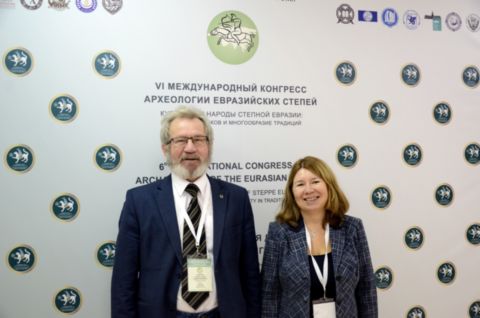Director of the SUSU Eurasian Studies Research and Education Centre Aleksandr Tairov and Senior Research Fellow Nataliia Berseneva took part in the 6th International Congress of Archaeology of the Eurasian Steppes, which was held at the Academy of Sciences of the Republic of Tatarstan. The congress brought together hundreds of participants from Russia, Kazakhstan, China, Hungary, and Bulgaria.
Aleksandr Tairov presented a report on the "Caravans in the Steppes of Central Asia: Trade and Trade Routes". The goal of his research was to reconstruct the caravan routes that had passed through the steppes of Central Eurasia in late antiquity and the Middle Ages (1st millennium BC – 1st millennium AD). The material for the research included excavation data, written documents, maps and even aerospace images.
Caravans had headed from Central Asia to the Trans-Urals and Western Siberia. They had carried metal products, weapons, women's jewellery, mirrors, and rhubarb to the north; and had returned with furs, mammoth tusk products, and other gifts from the taiga.
As a result, it turned out that the caravan routes of antiquity (early Iron Age, and possibly Bronze Age) had not been very different from the trade routes of the 18th to 19th centuries well documented in historical sources. They had been determined by overcoming natural barriers (rivers, mountain passes), the characteristics of pack animals (relatively speaking, a camel had had to cover the distance from one irrigation ditch to the next irrigation ditch during daylight hours, approximately 20 to 25 kilometres per day). Settlements had emerged along these populated routes, which had then been connected by roads, so it is not surprising that modern routes also pass along approximately the same “natural corridors”.
Nataliia Berseneva offered the conference participants a structural and age analysis of burials of the early Iron Age nomads in the South Ural region (5th to 3rd centuries BC). It turned out that adult men, regardless of age, had been buried in approximately the same way: weapons had been placed in their graves. Naturally, jewellery and mirrors had been placed in women's graves, but the older the deceased, the less jewellery there had been. Moreover, young women had been sometimes buried with weapons or horse harnesses, like men. Having analysed the data on the burials of 283 people, Nataliia Berseneva concluded that the period of social activity of men (nomads of the South Ural region related to the early Iron Age) had lasted longer than that of women.
The Chelyabinsk archaeologists Aleksandr Tairov and Natalia Beresneva also took part in the round table, which resulted in a decision to prepare a multi-volume work on the archaeology of the Eurasian steppes for publication.
The participation of the SUSU scientists in the congress was supported by funds from the Russian Science Foundation.




